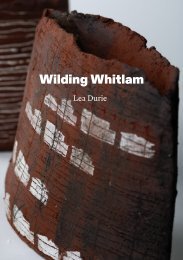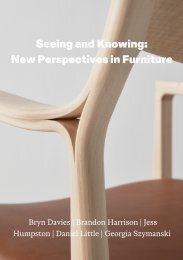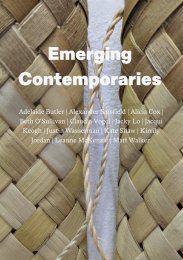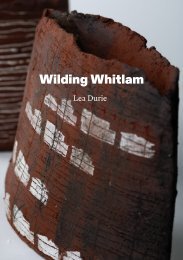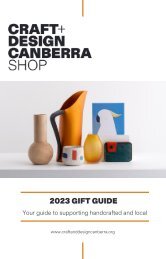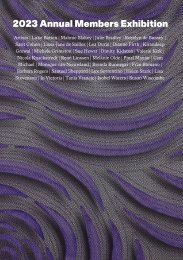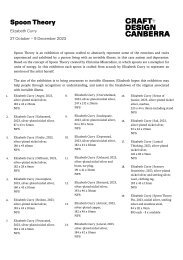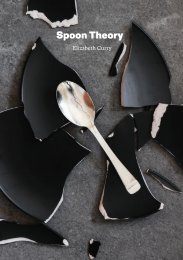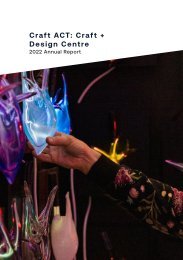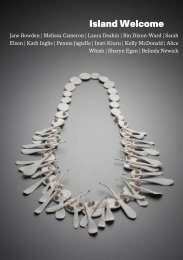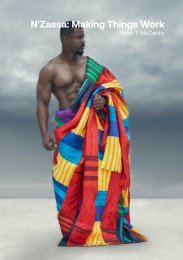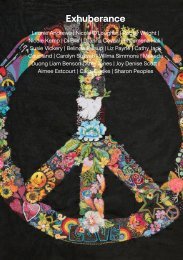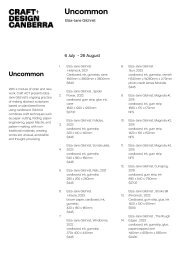After
27 August - 17 October 2020 Kasia Tons After by emerging Adelaide-based artist Kasia Tons is a solo exhibition of textiles and photography. Kasia uses textiles to create soft sculptures, 2D works, and wearables that explore personal narratives with universal themes such as home, identity, constructive chaos, and interpersonal relationships. She has been inspired by the little known E.M Forster novella The Machine Stops (1909) which describes a futuristic society where a machine which sustains daily life suddenly stops. This delightfully quirky exhibition explores a time after technology has thrived. After the technology dies, the hole that is left is filled with creative entertainment and expressions reminiscent of times gone past.
27 August - 17 October 2020
Kasia Tons
After by emerging Adelaide-based artist Kasia Tons is a solo exhibition of textiles and photography. Kasia uses textiles to create soft sculptures, 2D works, and wearables that explore personal narratives with universal themes such as home, identity, constructive chaos, and interpersonal relationships. She has been inspired by the little known E.M Forster novella The Machine Stops (1909) which describes a futuristic society where a machine which sustains daily life suddenly stops.
This delightfully quirky exhibition explores a time after technology has thrived. After the technology dies, the hole that is left is filled with creative entertainment and expressions reminiscent of times gone past.
Create successful ePaper yourself
Turn your PDF publications into a flip-book with our unique Google optimized e-Paper software.
AFTER<br />
KASIA TONS<br />
Craft ACT Craft + Design Centre
Craft ACT: Craft + Design Centre is supported by the ACT<br />
Government, the Visual Arts and Craft Strategy – an initiative<br />
of the Australian State and Territory Governments, and the<br />
Australia Council for the Arts – the Australian Government’s arts<br />
funding and advisory body.<br />
CRAFT ACT CRAFT + DESIGN CENTRE<br />
Tues–Fri 10am–5pm<br />
Saturdays 12–4pm<br />
Level 1, North Building, 180 London Circuit,<br />
Canberra ACT Australia<br />
+61 2 6262 9333<br />
www.craftact.org.au<br />
Cover: Kasia Tons, Untitled #3, 2020. Photo: Dave Laslett<br />
Page 4-5: Kasia Tons, Untitled #1, 2020.<br />
Photo: Dave Laslett
AFTER<br />
KASIA TONS<br />
Craft ACT Craft + Design Centre<br />
27 August - 17 October 2020<br />
3
4
5
<strong>After</strong><br />
Exhibition statement<br />
Who knew that over the course of this year<br />
our world would become even closer to<br />
the one described in the book that inspired<br />
me to create <strong>After</strong>. 1<br />
I set off at the end of 2019 for two months<br />
of walking. Embroidery in tow, for the<br />
purpose of plunging myself into a digitally<br />
reduced experience. Hiking up and down<br />
mountains, crossing rivers and having<br />
many conversations with fellow hikers<br />
about food, pack weight, weather and<br />
distance. Weather updates were hand<br />
written and left in huts by rangers who<br />
had walked in for this purpose and others.<br />
We were all having a direct experience<br />
of nature, each other and ourselves. An<br />
ever-changing community of intention. At<br />
times I was alone for days. My walking,<br />
punctuated by meals, tea, making fire,<br />
letter writing and embroidery.<br />
A couple of weeks after returning from<br />
the walk the pandemic hit. Life went<br />
from feeling infinite in a natural sense to<br />
infinite in a digital sense. The internet was<br />
utilised like never before to socialise, to<br />
entertain and to document ourselves into<br />
mundanity.<br />
I have always been aware of my screen<br />
addiction tendencies, partly why ‘The<br />
Machine Stops’ captured my attention<br />
so strongly as a text of foreboding.<br />
But I didn’t resist. I became as internet<br />
dependent as everyone else. I went to the<br />
theatre online, documented my attempts<br />
at food growing, documented my dog,<br />
documented myself and spoke most<br />
days with a different friend either through<br />
messaging or video calls. Only to feel a bit<br />
empty.<br />
These two opposing experiences have<br />
fed into the work produced for this show.<br />
I have been interested in what I’ve heard<br />
from others during these times from a<br />
mental health perspective in addition to<br />
my own experience. This imagining of a<br />
future world where nature is valued and<br />
central, where there is deep connection<br />
with others and ourselves and where there<br />
is a return to handmade crafts is not a<br />
new idea. It is an image of Utopia that has<br />
been imagined with slight variations since<br />
ancient times. 2<br />
The recurring motifs of nature throughout<br />
the pieces are inspired both by the art of<br />
6
floriography 3 and William Morris 4 , who,<br />
could very well be the environmental<br />
soothsayer as Forster is for digital<br />
technology. I wanted environmental<br />
connection to be the central force<br />
in this post screen addicted society.<br />
Alongside mask and costume that can<br />
provide both comfort, decoration and<br />
psychological expression as the wearer<br />
eases themselves from a world where they<br />
are very much in control of how they are<br />
seen with the plethora of filters and digital<br />
adornments to a world where they may<br />
feel a sense of exposure and nakedness.<br />
The masks vary from obscuring the face<br />
entirely to being quite transparent and<br />
acting more as an adornment or real-life<br />
filter.<br />
and create is at the core of our nature and<br />
when we explore by choice or necessity<br />
these aspects of our self it can leads to a<br />
more satisfying experience.<br />
[1] The Machine Stops, E.M Forster, 1909<br />
[2] Utopia, the history of an idea, Gregory Claeys,<br />
2020<br />
[3] Daffodil: new beginnings and also the common<br />
name for the genus scientifically known as Narcissus.<br />
Nasturtium: Impetuous love. Chrysanthemum: Truth.<br />
Bougainvillea: Passion; The Language of flowers,<br />
Mandy Kirby 2011<br />
The role constructive chaos plays in<br />
transformation of society is a recurring<br />
theme I work with and is present here as<br />
well. We’ve seen this year how quickly life<br />
can change, the way we function, what<br />
we prioritize and what is meaningful. Both<br />
hiking in the mountains and living through<br />
a worldwide pandemic lockdown has<br />
shown that security in life is an illusion but<br />
our ability to problem solve, adapt<br />
Page 8-9: Kasia Tons, Untitled #4, 2020.<br />
Photo: Dave Laslett<br />
7
8
9
Exhibition essay<br />
Catalogue essay: Valerie Kirk<br />
The title of the show begs the<br />
question……but what came before? Was<br />
there an event? What happened?<br />
Textile Artist, Kasia Tons was inspired<br />
by the science fiction short story, “The<br />
Machine Stops” by E. M. Forster. The<br />
novella presents a future world where<br />
humans live underground, governed by<br />
a machine. When it was published in<br />
1909, the ideas presented must have<br />
seemed like a total fantasy: people<br />
ruled by a device made by humans,<br />
technology; completely removed from<br />
the natural world, living alone under the<br />
surface of the earth; restricted, locked<br />
down and socially distanced. However,<br />
in 2020, battling COVID 19 we are faced<br />
with questions about our reliance on<br />
technology, disregard for our natural<br />
environment and coming to terms with<br />
“the new normal”. Kasia searches for<br />
answers to what we have lost through<br />
dependence on the internet and social<br />
media, distance from nature and people.<br />
She values the work of William Morris<br />
as a social activist and champion of<br />
handmade textiles embodying nature.<br />
Growing up in the country she enjoyed<br />
freedom to explore and have adventures,<br />
build shelters and learn navigation skills<br />
through paying attention to the details<br />
of nature. As an adult, Kasia returned<br />
to this world by spending two months<br />
walking in NZ, crossing rivers and<br />
mountains, exposed to the elements, her<br />
inner world and sometimes other hikers.<br />
Her backpack contained a cloth for hand<br />
embroidery as a constant companion.<br />
Day by day she drew in pen on the<br />
fabric as she walked, then stitched in<br />
the evenings or while staying in one<br />
place for a couple of days. Like a diary<br />
it became a record of her thoughts and<br />
responses, reflections and interactions<br />
with others. It carries the physical patina<br />
of being in the environment, not washed<br />
clean but holding the experience and<br />
memories.<br />
Back in the Adelaide studio, new<br />
work could develop using materials<br />
and processes that are not so easily<br />
transportable - beading, felting, stitching<br />
into paper and three dimensional<br />
10
sculpting of materials. The mask form<br />
with varying transparencies holds ideas<br />
about opening up to other people face to<br />
face in the real world. A new exploration<br />
sewing on paper conveys a feeling of<br />
rocks and being comforted or hugged by<br />
the mountain.<br />
“<strong>After</strong>” makes us think about the<br />
possibilities beyond the world<br />
of technology we have grown so<br />
accustomed to. It encourages us to<br />
reconnect with the freedom of selfexpression<br />
through making, building on<br />
our traditions to reflect our world and tell<br />
new stories.<br />
Valerie Kirk,<br />
Artist and Tapestry Weaver, 2020.<br />
11
Kasia Tons<br />
Biography<br />
Kasia Tons, born Adelaide (1985), is<br />
a Textile Artist living on Peramangk<br />
country of the Adelaide Hills. She creates<br />
colourful, chaotic soft sculptures,<br />
wearables and 2D pieces with obscured<br />
personal mythologies entwined with<br />
more universal themes of home, identity,<br />
belonging, connection and movement.<br />
Her current areas of interest are futuristic<br />
health, design and agriculture, the societal<br />
implications of excessive technology use<br />
as well as the traditions of story-telling<br />
and daily life. Her artistic influences are<br />
Judith Scott, Nick Cave and Anthony<br />
Stevens.<br />
the RSI that comes with years of doing<br />
small, repetitive movements typical of<br />
embroidery.<br />
She holds a degree in Textile Design, RMIT<br />
for which she received the DIA’s graduate<br />
of the year award and also an honours<br />
in Sculpture from UTAS. Her work has<br />
been exhibited throughout Australia and<br />
Eastern Europe and she has participated<br />
in residencies and symposiums in Iceland,<br />
USA, Latvia and the Slovak Republic. The<br />
Mark Rothko Art Centre, Latvia holds two<br />
of her pieces as part of their permanent<br />
collection.<br />
Hand embroidery has been central to her<br />
work since first picking up a needle and<br />
thread in 2006, but of recent years she<br />
has been actively exploring the use of<br />
larger movements with greater energetic<br />
output both as a physical expression for<br />
her feelings but also as a way to combat<br />
Opposite: Kasia Tons, Untitled #2, 2020.<br />
Photo: Dave Laslett<br />
13
14
15
16
17
List of works<br />
1 <strong>After</strong>, 2019-20<br />
hand embroidery, wool,<br />
cotton, canvas base<br />
$24,000<br />
6 Bonnet, 2020<br />
felt, needle felting, beading,<br />
hand embroidery, wire, paint<br />
$4,200<br />
2 Screentime mask 1, 2020<br />
hand embroidery, fly screen<br />
base<br />
$1,120<br />
7 Tree, 2020<br />
Desert commando tent,<br />
machine sewing, hand<br />
embroidery, beading, felt<br />
$5,600<br />
3 Screentime mask 2, 2020<br />
hand embroidery, fly screen<br />
base<br />
$840<br />
8 Nook, 2020<br />
felt, needle felting, found<br />
objects, paint, hand stitching<br />
and beading, textas<br />
$5,600<br />
4 She is the Spirit of the<br />
doorway leading out, 2017-18<br />
hand embroidery, applique,<br />
beading, assorted reclaimed<br />
materials<br />
$1,680<br />
9 Mountain Blanket, 2019-20<br />
water colour paper, hand<br />
stitching, needle felting, wool,<br />
paint<br />
$3,500.00<br />
5 The heavy mask, 2019-20<br />
felt, needle felting, hand<br />
embroidery, pebbles<br />
$840<br />
10 Kasia Tons + Dave Laslett<br />
Untitled 1, 2020<br />
Photographic print on Canson<br />
platine fibre rag<br />
$560<br />
18
11 Kasia Tons + Dave Laslett<br />
Untitled 2, 2020<br />
Photographic print on Canson<br />
platine fibre rag<br />
$365<br />
13 Kasia Tons + Dave Laslett<br />
Untitled 3, 2020<br />
Photographic print on Canson<br />
platine fibre rag<br />
$365<br />
14 Kasia Tons + Dave Laslett<br />
Untitled 4, 2020<br />
Photographic print on Canson<br />
platine fibre rag<br />
$620<br />
15 Kasia Tons + Jonathan<br />
Daw + Jeremy Conlon<br />
Daffodil, 2019<br />
stop motion animation<br />
Page 14-15: She is the spirit, 2020. Photo: Craft ACT<br />
Page 16-17: Nook, 2020. Photo: Craft ACT<br />
19




